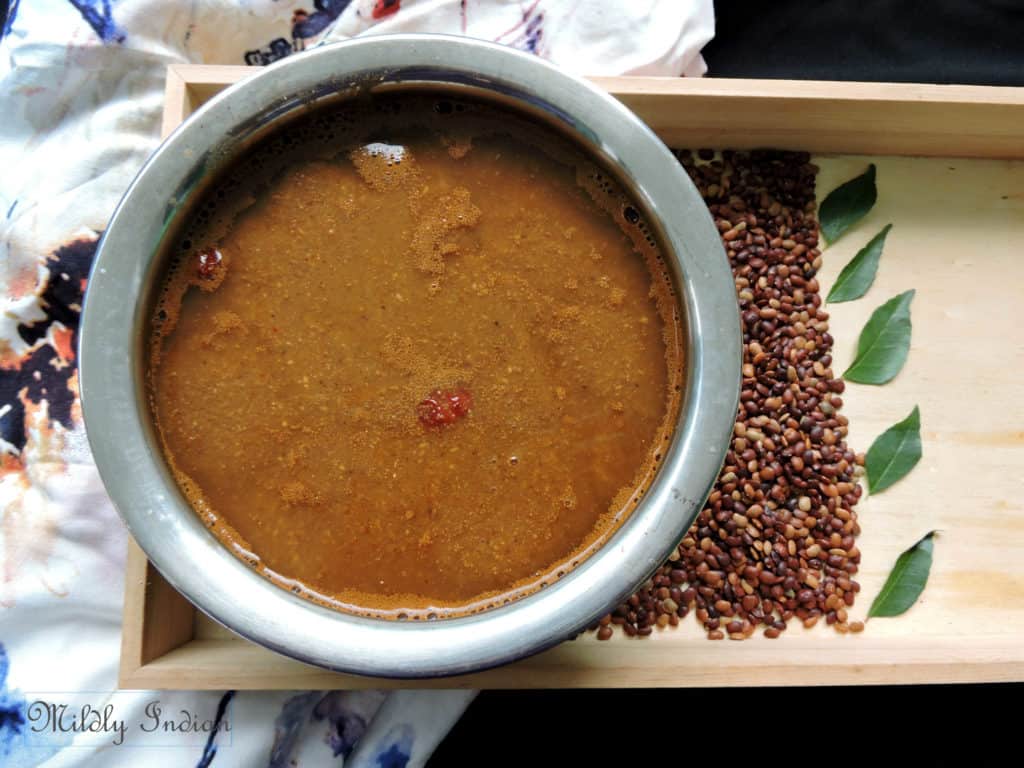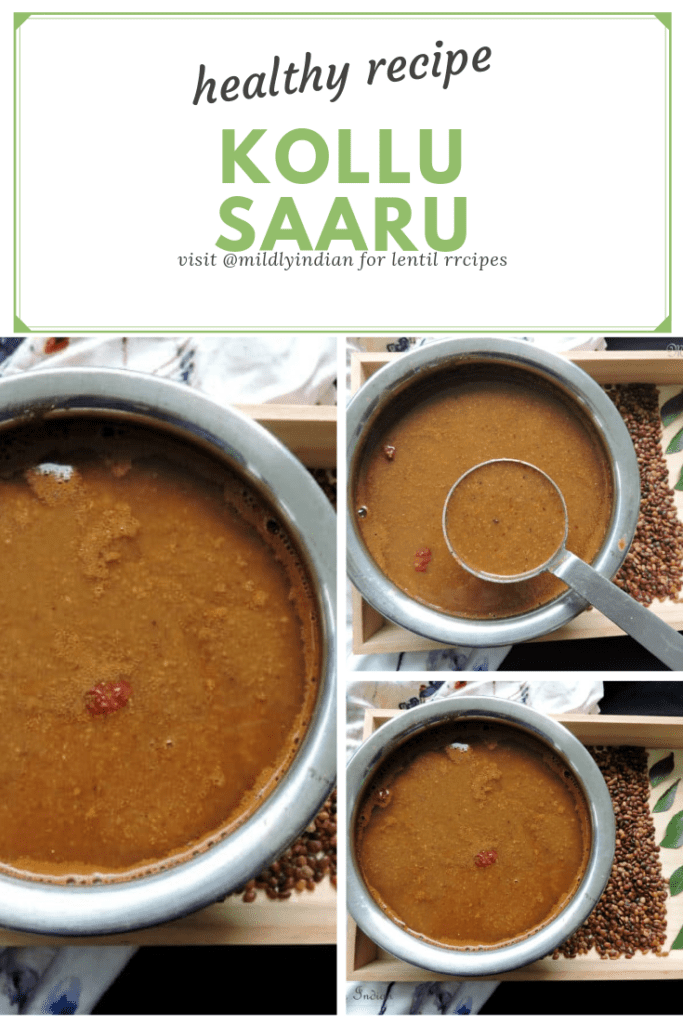In the glam world of Indian takeaways with their popular yellow dal and channa masala among all the creamy curries, a lot of nutrients beans and lentils miss out on the limelight. One such is the horsegram, a plain Jane brown lentil that stayed humble all along. Yet, households like mine have figured out that these are so much better than the popularised yellow dals. So we cook horse gram more often than the others..
One of the recipes I make so often is the kulith saaru. This was taught to me by my sister-in-law and slowly became a staple in my menu. It is lighter gravy that goes well with a plate of rice, some applam and Sunday stories.
One of the recipes I make so often is the kulith saaru. This was taught to me by my sister-in-law and slowly became a staple in my menu. It is lighter gravy that goes well with a plate of rice, some applam and Sunday stories.
What is horse gram?
Though not as popular as green gram or red bean, the horse gram is popular in rustic Indian cooking. Macrotyloma uniflorum is a plant whose seeds are consumed from ancient times in South India. Horse gram has been attributed to a nutty and smoky flavour that blends well with the masala spices and coconut-based curries. Nutritionally dense with high iron content the beans are making their way back into the superfood category slowly.
Why is horse gram considered hot?
Horsegram is listed are a winter bean. This is probably because it is a protein-rich bean that is also rich in minerals. This releases a lot more energy and heat to the body (hence fed to race horses). So go by your body and digestibility when you are using this bean. Ensure you have plenty of exercise on that day so you can digest it well. Sprouting the bean helps in improving the digestive properties like we have done to make horse gram chaat.
Ingredients to make kulith saaru
Horsegram
To make the masala base
Tamarind pulp
Let’s make horse gram curry
What pairs well with horse gram curry?
Horsegram curry in my house is always with rice. Soft red raw rice varieties or white rice like sona masoori or ponni are my favourites. On the sides, we have a light stirfry like cabbage or eggplant, a few bitter gourd pakoda and some karuvadam. Finish the meal with a light rice rava payasam or a piece of doodh barfi. Now that is a Sunday meal at home.

Kulith saaru
Horse gram curry is a delicious south Indian stye recipe that pairs well with steamed rice for lunch. Enjoy this healthy unusual, gluten free, tree nut free recipe as a winterwarmer.
Equipment
- deep pot
- blender
Ingredients
To pressure cook
- 1/2 cup horse gram
- 2.5 cups drinking water
For the masala
- 1 tbsp coriander seeds
- 2-3 tbsp dessicated coconut
- 4-5 dry red chilli
- 10 curry leaves
- salt to taste
- 1/4 tsp cumin seeds
- 1/4 tsp turmeric powder
- 1 pinch Asafoetida
for the tamarind pulp
- 1 lime sized ball tamarind or 1/2 tsp tamarind paste conc.
- 1/4 cup Water
for tempering
- 1 tsp coconut oil ( any cooking oil is fine)
- 1/4 tsp mustard seeds
- 1/4 tsp cumin seeds
- 4-5 curryleaves
- 1 dry red chilli broken into bits
Instructions
- Collect all the ingredients needed for the preperation

- Wash and drain the horse gram to remove any impurities.

- Add the 2,5 cups of water and pressure cook the horsegram for about 4-6 whistles
- Release pressure naturally (about 10-15 minutes)
- Gently mash the cooked horse gram and set aside
- Mean while, Dry roast the coconut, the curry leaves, the coriander seeds, chillies and cumin seeds till aromatic
- Make this mix into a smooth powder and add 1 ladle full of the horse gram plus the cooking liquid and grind further into a smooth paste

- Into a wok add the oil and ingredients for the tempering

- When the mustard seeds crackle, add the cooked mashed horse gram and the masala paste prepared.
- Add salt to taste and the tamarind pulp

- Simmer this for about 6-8 minutes
- The kulith saaru is now ready to serve

Notes
In the instant pot it takes 35 minutes on high pressure to get the beans cooked. Wait for natural pressure release to ensure they are cooked well.
Nutrition
Calories: 113kcalCarbohydrates: 15gProtein: 4gFat: 4gSaturated Fat: 2gPolyunsaturated Fat: 1gMonounsaturated Fat: 1gSodium: 11mgPotassium: 219mgFiber: 2gSugar: 1gVitamin A: 168IUVitamin C: 51mgCalcium: 70mgIron: 2mg
Tried this recipe?Let us know how it was!
How long does kulith saaru stay?
Kulith saaru made on Sunday lasts in the fridge well till Friday. This is why I like it in my meal prep. It can be frozen for up to 3 months and thawed to consume. So feel free to make the biggest pot of saaru and portion it out.
Stay connected
Kulith saaru recipe is a much-loved recipe that has been on this blog since 2019. I guess it was high time it finally received an update in content. The recipe remains the same, as I don’t think I would ever like to change this version. Share with us if you like horse gram or how you use it in the comments. If you happen to make kulith saaru, do let us know if you liked it by hitting the star rating.
Thank you for staying subscribed and supporting our culinary journey.
See you at the next post.
Thank you for staying subscribed and supporting our culinary journey.
See you at the next post.






I love horsegram rasam too, though we make it slightly differently from your version. This looks super flavourful and hearty. Will try out your method the next time around. 🙂
Horse gram rasam is a wonderful separate recipe. I kind of added the north Karnataka influence to it like my sis in law does.
I always love the flavour of horsegram. I make kollu rasam in a slightly different method. Will try yours too next time.
Ahh finally met a person who likes the flavour of horsegram… yes the rasam is a much thinner version than this curry
The saaru sounds very flavorful and super delicious… Uppa would make fun saying that this is what horses eat, but I always tell him why are we depriving ourselves of such a delicious lentil!
My dad used to say the same too as mum only made a chammandi with it and I used to use that excuse to say I don’t want to eat it. but yes, sure miss for all the health benefits if we don’t use it.
Horsegram curry sounds spicy tangy and super yummy. Adding horsegram made the curry healthy too. Loved it. Saving it to try sometime.
it is indeed a medium spicy recipe and a very healthy one.
Kulith is something I have learnt about recently. Yet to introduce it in my family’s diet. (The task is bound to be uphill) but will definitely try it. Love the pics bookmarking
I totally hear you when you say about the uphill task. Try in small amounts, a mix of dals initially so they feel comfortable.
I’m truly surprised why this power packed nutritious bean has not been brought to the limelight. I’ve not used horse gram and didn’t know about its value till I read your post. Definitely going to try and include it in my diet more often. Thanks for sharing the info and an easy dal recipe using horse gram.
This saaru looks absolutely delicious and flavourful with so many spices in it. I’m sure the spices mask the horsegram flavour so that my family members who doesn’t like horsegram may not know what is being used in the saaru. Bookmarking this recipe to try sometime.
Horse gram curry sounds interesting. The curry looks delicious. Bookmarking it for future use as my family loves spicy food (specially southindian food)
I love horsegram rasam. Your recipe is different from how we make it in Andhra and I plan to try your version soon.
I am happy that my family has readily accepted this super grain and I can’t wait to try your saru recipe. This horsegram saru sounds like a wholesome soup which is perfect for the weather here right now.
This horsegram curry looks absolutely delicious and flavourful with so many flavours and medium spices in it., which I loved it most. This looks super comfort and hearty soup. Will try out your method.
Horse gram curry looks so flavorful. Perfect with hot steaming rice and lunch is sorted.
Very nutritious and rich in flavours!! Never tried horsegram but after reading the health benefits it, will love to try this for sure
This sounds super delicious. Along with all the goodness of horse gram ,a lip smacking curry, what more anybody can want. Loved the recipe!!
Awesome !!! curry using horse gram sounds interesting it must taste great with some steamed rice ..
Kulith as I know this horsegram as is what I have tried once n never enjoyed. I believe there is a Zunka made too mu friends swear by but frankly the color puts me off. So I am glad I am not the only person turned off.
Since you say it tastes good I am going to try it out as the rasam. Fingers crossed n toes too.
My mother in law used to make this saaru. And it was so delicious . She made rice roti to go with it or ragi balls.
I am glad I brought back some good memories. We like it with rotti too,
Kulith Saaru is so delicious and tempting . Perfect to enjoy in the cold wet weather. One of the best Saaru variety.
Wow seema kulith saaru sounds delish, i was expecting a rasam here, but this is almost similar to our milagu kuzhambu style. I m definitely try this kollu saaru soon. Steaming hot rice and ladles of this saaru is bliss on plate.
I have some horse gram and have soaked them to make kulith saaru. Such a flavourful and healthy curry. This will give an opportunity to try cooking horse gram in a different way to what I usually make.
I am yet to start using it in my kitchen. Will make this rasam for my son who was asking about it. Looks flavoursome.
a different, delicious take on Kollu Rasam.. I love the arichuvitta masala paste in this saaru. a must try during winters
This kulith saaru looks delicious. It reminds me of a sweet and sour rasam. I love the way you have combined all the flavours in this dish.